Physiognomy and Portraits of Shakespeare
From Shakespeare the Player by Alexander Cargill. London: Constable and Company Ltd.
Beyond what mere tradition has to say on the subject, and omitting at present certain supposed personal references to himself in the Sonnets, there is nothing (excepting, of course, the portraits and only what these suggest) to throw any light on the interesting
question as to what manner of man Shakespeare was in the physiological sense. Was he a tall or medium-sized or small man? Was he physically robust or otherwise? Was his complexion dark or fair? In short, what were the chief physical characteristics which differentiated him
from ordinary men of flesh and blood? The subject is of much interest could facts regarding it be obtained.
...Shakespeare was not only a phenomenon in point of intellectual genius, but he must also have been superbly gifted in the matter of physique. And in this twofold consideration, where can we find his equal in the records of human history? In Leonardo da Vinci, perhaps.
Too little regard has been paid to this aspect of the life and work of Shakespeare; and one has only to consider for a moment, in connection with the absurd heresy as to the authorship of the plays, to find how futile is the endeavour to assign that authorship to a man built physically and temperamentally on such lines as was Bacon.
The writing of the plays (of William Shakespeare) was a sheer physical impossibility to Francis Bacon. Let us, then, consider the portraits with a view to arriving at some reasonable conclusion with regard to the main features of the physiognomy of Shakespeare. And to this end I shall only examine the two authentic portraits of the
dramatist, viz., 'the Bust' and the 'Droeshout' likeness prefixed to the First Folio edition of his works. I should have liked to include the 'Stratford likeness, the 'Jansen'
portrait and the 'Felton Head' also, as they suggest so much that is akin to my own individual leanings with regard to the matter of Shakespeare's physiognomy, but I must
omit any details regarding them, as they can only be considered as more or less doubtful if not ideal portraits. They are therefore referred to as belonging to the latter category.
The Bust of Shakespeare
As all the world knows, this is erected in the chancel of the Church of Holy Trinity in his native town of Stratford-on-Avon. With this likeness generations of pilgrims to
that classic shrine have been familiar, ever delighted to gaze upon the marble image with profound admiration.
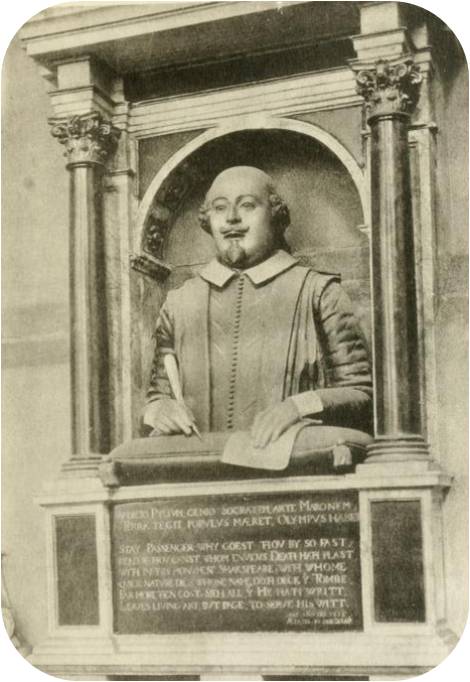 It is believed that when Shakespeare died, on the 23rd April 1616 (o.s.), exactly fifty-two years of age, a cast of his features was taken— by whom is not known, though the
name of the sculptor of the bust, Gerard or Gerald Johnson, a Hollander, has been suggested. Johnson has been credited with having done his part of the work well, since, before its
erection in the chancel of the church, the bust was probably approved by Shakespeare's relations as a good likeness, and deemed worthy of its conspicuous position and of the man
it represented. As is well known to all who have seen the bust, its prominent characteristic is the calm serenity and gentleness of the expression of the features, an expression
that fairly well satisfies the popular ideal of England's
greatest poet. It is believed that when Shakespeare died, on the 23rd April 1616 (o.s.), exactly fifty-two years of age, a cast of his features was taken— by whom is not known, though the
name of the sculptor of the bust, Gerard or Gerald Johnson, a Hollander, has been suggested. Johnson has been credited with having done his part of the work well, since, before its
erection in the chancel of the church, the bust was probably approved by Shakespeare's relations as a good likeness, and deemed worthy of its conspicuous position and of the man
it represented. As is well known to all who have seen the bust, its prominent characteristic is the calm serenity and gentleness of the expression of the features, an expression
that fairly well satisfies the popular ideal of England's
greatest poet.
Since its erection in the chancel — some time between 1616 and 1623 — the bust has experienced not a few vicissitudes. Originally coloured over to resemble life, a custom of the period, the bust was never once restored or touched up
in any way till 1748 — a century and a quarter afterwards —
when its condition after such a lapse of time can be readily imagined. In the latter year, however, at the instance of an ancestor of the famous actress, Mrs. Siddons, it received
careful and loving attention; the old colours were fetched forth anew, and the monumental setting was improved and made worthy of the poet. The necessary expenses of this
work were, it is interesting to note, defrayed out of the
profits of a representation of the play of Othello by a company of actors 'strolling' by Stratford-on-Avon at the time.
Nearly fifty years after, Mr. Malone, well known in his day as an enthusiastic admirer and commentator of Shakespeare, bethought him that the bust required further
renewing, and took it upon himself to 'cover it over with one or more coats of white paint, thus,' in the opinion of those who witnessed the sacrilegious act, 'at once destroying its
original character and greatly injuring the expression of the face.' For this unfortunate display of hero-worship Malone was severely censured, and there is at least one record extant
that expresses in a measure the feeling of annoyance his action created at the time. In the old visitors' album at the Church of Holy Trinity the following lines were inscribed
as a protest against Malone's offence :
Stranger, to whom this monument is shewn,
Invoke the poet's curse upon Malone;
Whose meddling zeal his barbarous taste betrays,
And daubs his tombstone, as he mars his plays!'
The bust remained for many years in the condition in which Malone had left it. Eventually, however, it was restored once more. Malone's daub was completely obliterated, and the original colouring, as 'improved' in the year 1748, as far as possible renewed. In that satisfactory condition the bust has, with careful tending, remained ever
since, though it has been occasionally touched up to preserve the glorious features of the carved marble as they deserve to be, and doubtless will be, preserved in all time
to come.
The inscriptions on the mural tablet below the bust must, of course, ever claim regard for their references to the death of Shakespeare, but they are quite overshadowed in importance by the well-known inscription engraved on the stone slab that covers the tomb, since tradition has it that the lines were the composition of the poet himself, and penned,
very probably, when on his death-bed. They read as follows 1:

The 'Droeshout' Portrait
In point of intrinsic worth and literary interest the 'Droeshout' portrait of Shakespeare— an engraving of his likeness given to the world for the first time along with the
original edition of his collected works in 1623 — ranks next to the Stratford bust. Some authorities place what is known as the 'Chandos' portrait of the poet before the 'Droeshout'
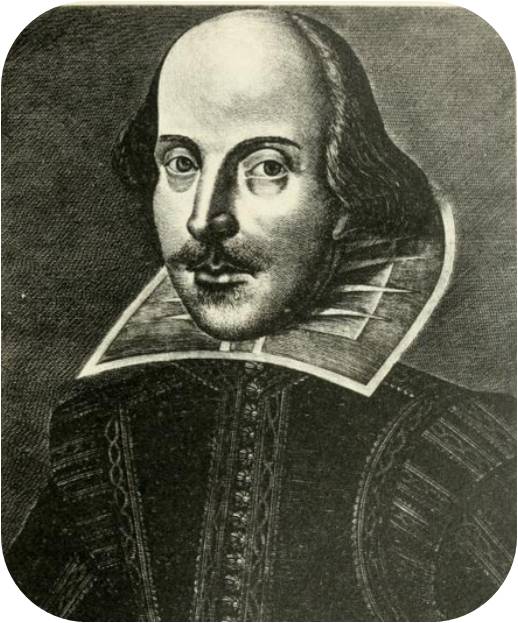 print; while, again, others value the print even before the bust. But there are one or two good reasons why, in this particular instance, the work of the engraver should be more
highly valued than that of the painter. print; while, again, others value the print even before the bust. But there are one or two good reasons why, in this particular instance, the work of the engraver should be more
highly valued than that of the painter.
In the first place, the 'Droeshout' engraving was executed by a skilful artist whose profession it was to 'draw from the life'; whereas the 'Chandos' portrait is only supposed to
have been painted by one or other of two men whose calling was that of the player.
The 'Droeshout' engraving bears, in the second place, the special imprimatur of Shakespeare's associate, Ben Jonson; and not only his, but it also has the endorsement of the poet's intimate friends and 'fellows,' Heminge and Condell, who were remembered in his last will and testament.
In the third place, there is the suggestive fact that between the Stratford bust and the 'Droeshout' engraving there are certain striking correspondences, not so observable
between the bust and the 'Chandos' portrait, that have led the best authorities to infer that the sculptor of the bust in all probability had the engraving before him while executing
the details of his work, though modelling mainly from the mask taken after the poet's death. If that inference be correct, it again further shows that the 'Droeshout' print had received the approval of the poet's relatives, and also that Heminge and Condell obtained their sanction before affixing it side by side with Ben Jonson's dedicatory lines
in the forefront of the famous First Folio (1623). These lines declare as follows:
'To the Reader
This figure that thou here seest put,
It was for gentle Shakespeare cut,
Wherein the graver had a strife
With Nature, to out-do the life:
O could he but have drawne his wit,
As well in brasse, as he has hit
His face; the print would then surpasse
All that was ever writ in brasse:
But since he cannot, reader, looke
Not on his picture, but his booke.
B. J.'
In this work of Martin Droeshout there is nothing, beyond what the print itself bears, to tell of the circumstances in which it was originally executed. Assuming that other portraits of the poet were, in addition to this one, executed during his lifetime, the 'Droeshout' print was doubtlessly one of the earliest. Its date, however, is unknown. Judging from the appearance of the face generally, and comparing that with his other likenesses, Shakespeare
had not, it is pretty certain, attained his fortieth year when, with this portrait, "the graver had a strife With Nature."
The 'Chandos' Portrait
Of the countless editions of the works of Shakespeare that show a frontispiece likeness of the poet, it is a singular fact that by far the greater number favour the 'Chandos'
portrait. The face and features of Shakespeare as 'imaged' in that portrait are those with which his readers are probably most familiar. It is not easy to account for this, since the
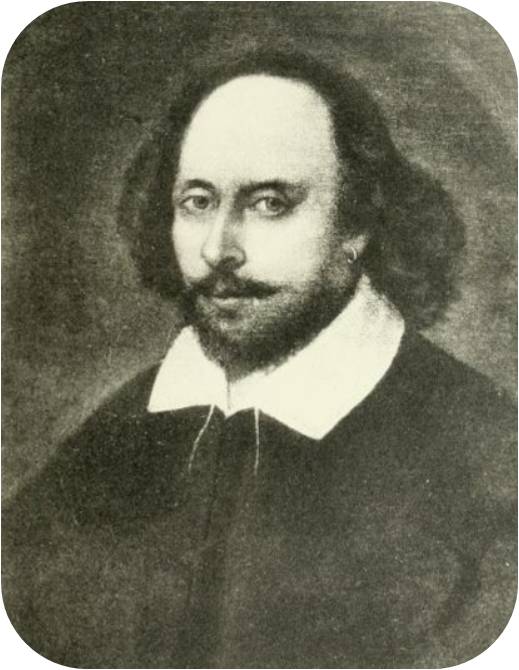 portrait is certainly not the first in point of genuineness, whatever may be its degree of artistic merit. Possibly it satisfies more fully the popular ideal of the likeness of a great
creative poet than does the bust or print just referred to. Be that as it may, the 'Chandos ' portrait, for various reasons, more than justifies its being kept in the custody of the
nation as a very rare and valuable relic of its greatest dramatist. Its history is, briefly, as follows. portrait is certainly not the first in point of genuineness, whatever may be its degree of artistic merit. Possibly it satisfies more fully the popular ideal of the likeness of a great
creative poet than does the bust or print just referred to. Be that as it may, the 'Chandos ' portrait, for various reasons, more than justifies its being kept in the custody of the
nation as a very rare and valuable relic of its greatest dramatist. Its history is, briefly, as follows.
According to the catalogue of the National Portrait Gallery, where the relic is now safeguarded, 'The 'Chandos' portrait was the property of John Taylor, the player, by
whom, or by Richard Burbage, it was painted. The picture was left by the former in his will to Sir William D'Avenant. After his death it was bought by Betterton, the actor, upon whose decease Mr. Keck, of the Temple, purchased it for forty guineas, from whom it was inherited by Mr. Nicholls, of Michenden House, Southgate, Middlesex, whose only daughter married James, Marquis of Carnarvon, afterwards Duke of Chandos, father of Eliza, Duchess of Buckingham.' Hence the name of the portrait, and such, in substance, is all that is known with certainty regarding its history.
The 'Jansen' Portrait
It is a remarkable circumstance that not a few of the likenesses of Shakespeare should have been executed by others than his own countrymen. As its name would seem to imply, the 'Jansen' portrait was the production of a foreigner. There are others, also, of the Shakespearean likenesses yet to be considered that owe their origin very largely to the skill of devout admirers of the poet who were not in any way of his national kith or kin. In the 'Jansen' portrait, so called from the name of the painter, Cornelius Jansen, it is quite possible that we have a picture of Shakespeare that shows him as he appeared about his forty-
sixth year, and when approaching, if not already arrived at, the summit of his physical and intellectual strength and glory. It is also possible that the likeness was painted as a
memento or token of that friendship and regard which were entertained for the poet by the Earl of Southampton almost from the outset of Shakespeare's career.
The 'Felton' Portrait
Apart from the question of authenticity, it is safe to say that the likeness of Shakespeare known under the name of the 'Felton Head' is one that will probably fascinate the
great majority of the poet's admirers more than any other portrait. It will, however, speak for itself as to this. But for a somewhat severe and sad, if not dissatisfied, look
that seems to haunt the eyes, the portrait takes rank, in at least its excellence of ideality, with any other example. Allowing for some exaggeration in the height of the forehead, a defect which has led some experts to infer that the 'Felton' portrait was in existence even before the 'Droeshout' print, and that, indeed, it served as the model for the engraver, it is assuredly a splendid portrait of Shakespeare, and
speaks eloquently of the painter's lofty conception of the
poet's features. Its history is curious, if for nothing more than the fact that the name, 'Gul Shakespear,' and the date, '1597,' together with the initials, R. B.,' traced on
the reverse side of the picture, indicate the likeness to have been, as some authorities believe, the handiwork of Richard Burbage, the player, who is thus for the second time
identified with his great contemporary in this interesting
connection.
The 'Becker' Mask
In the year 1849 there was discovered at Mayence what bore to be a genuine though gruesome relic of Shakespeare, and claimed to be set almost side by side in value and interest
with the Stratford bust itself. This relic was declared to be nothing less than the mask of the face and features of the poet taken after his death in April 1616 (o.s.).
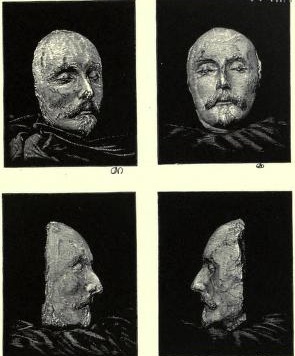 As nothing was
ever known as to what befell the mask after Gerard Johnson had manipulated it in the preparation of the bust — assuming it had been in his hands for that purpose — the finding of
such an extraordinary relic created widespread interest, not only throughout England and Europe, but in America, where also there were those who were ready to believe the
story.
As nothing was
ever known as to what befell the mask after Gerard Johnson had manipulated it in the preparation of the bust — assuming it had been in his hands for that purpose — the finding of
such an extraordinary relic created widespread interest, not only throughout England and Europe, but in America, where also there were those who were ready to believe the
story.
The resurrection of the veritable death-mask of the immortal author of Hamlet not unnaturally suggests, as it no doubt suggested at the time, a famous scene in the
last act of that famous tragedy. Nevertheless, its discovery was hailed with enthusiasm, and what purported to be an undoubted clue to a mystery more than two centuries
old was taken up at once and followed with rare persistence
by those who declared they held, in the possession of the
mask, the only key to its solution.
The gentleman into whose possession this curiosity came
was named Ludwig Becker, who, writing in 1850, gave so
entertaining an account of it as to induce Mr. Page, a well-known artist of New York, to visit Germany and there examine this famous relic for himself. After a prolonged
scrutiny of the mask, Mr. Page declared his firm belief in its genuineness, and thereupon made from it a very interesting set of models of the features of Shakespeare, which, at the
time, attracted great attention. An excellent account of the history of the mask was also written by Mr. Page for Scribner's Magazine of May 1876. The relic itself was
brought to London for exhibition, where it secured many
admirers and willing believers, and it is actually recorded
that some were so affected by the sight that they burst
into tears!
The 'Stratford' Portrait
Like the 'Becker' mask, the 'Stratford' portrait of Shakespeare, so called from its having been discovered in 1860 in that town, is quite a modern find. Whether the portrait had its original home in London or elsewhere is unknown; but, like the 'Becker' mask, it, too, was taken to the Metropolis for public exhibition. Many opinions were pronounced in favour of its genuineness, while many more unhesitatingly discredited it. At the time of its exhibition a newspaper warfare was waged over the question with results that, on the whole, were unfavourable to the pretensions of the portrait.
In this likeness Shakespeare appears as if in the very
flush and heyday of his early manhood and strength. A
robust, almost bucolic, massiveness and compactness is,
perhaps, the prominent physical trait. A calm, dignified
repose fills the full, winsome eyes, and at the same time
gently compresses the eloquent lips. The forehead is
ample: somewhat less lofty than in the bust, much less so
than in almost any other portrait, but still a fine, full, broad
brow that could only have been that of a highly gifted man.
Like so much else connected with Shakespeare, the history
of this portrait — when, and by whom, and for whom painted
— is unknown.
Some authorities believe it to have been the work of a
local artist, who either painted it to satisfy his own or
another's ideal. Some even incline to the view that it was
made to order, to do duty as a common tavern-sign! If
so, then it is surely one of the best examples of the kind ever
executed. After having been exhibited in London, the
picture was taken back to Stratford, where it has ever since
found a place of honour and safety.
The 'Hilliard' and 'Auriol' Miniatures
The former is by far the more interesting and meritorious.
When its pretensions to genuineness were put forward early
in the last century, the 'Hilliard' miniature belonged to
Sir James Bland Burges, Bart., who, in a letter to a friend
giving an account of it, alleged that it had been discovered
in a bureau which belonged to his mother, who had inherited it from her father, William Somerville the poet, and thus traced its history back to the days when the poet lived in
retirement at Stratford.
The 'Auriol' miniature is certainly more pretentious than the 'Hilliard,' though greatly inferior as a work of art or even as a likeness of the poet. It was claimed for it that it at
one time belonged to the Southampton family, but there is no evidence of this. It bears to have been painted when Shakespeare was in his thirty-third year, and it is recorded
that 'to the bottom of the frame of the miniature was appended a pearl, intended to infer that the original was a pearl of men.'
The 'Dunford' Portrait
If the likeness known as the 'Dunford' portrait has the slightest resemblance in any particular to Shakespeare, the individual must be exceptionally gifted who can trace it.
When its claims were put forward for the first time in 1815, Mr. Dunford, the owner, assured the public that he saw in the portrait a likeness to the "Droeshout" print.' Mr. Wivell, the well-known expert, compared them carefully and concluded that the resemblance was of the kind discovered by Fluellen between Macedon and Monmouth. When the portrait was exhibited shortly after its discovery in the year mentioned, it is recorded that 'of not more than six thousand
who went to see it, three thousand declared their belief in its originality.' Even an authority like Sir Thomas Lawrence voted in its favour. Moreover, it was twice engraved
by Turner in mezzotinto, so sincerely did many persons
believe in it as a true likeness of Shakespeare. Eventually,
however, it lost credit, and is now only remembered as an instance of that strange trait in the character of the British public, namely, its easy gullibility in matters appertaining
to Shakespeare.
Zoust's Portrait
An excellent likeness of the poet, which strikingly recalls the 'Chandos' portrait, is one that was alleged to have been painted by Soest, or Zoust. As that artist was not born
till 1635, when Shakespeare had been dead for nineteen years, his portrait must have been from a copy — probably that in the possession of Sir William D'Avenant, afterwards known as the 'Chandos' portrait.
How to cite this article:
Cargill, Alexander. Physiognomy and Portraits of Shakespeare. From Shakespeare the Player. London: Constable and company Ltd., 1916. Shakespeare Online. 20 Aug. 2009. < http://www.shakespeare-online.com/biography/portraitsfull.html >.
Note
1. Graphic added by Shakespeare Online editors (2014).
______
More Resources
 Queen Elizabeth: Shakespeare's Patron Queen Elizabeth: Shakespeare's Patron
 King James I of England: Shakespeare's Patron King James I of England: Shakespeare's Patron
 The Earl of Southampton: Shakespeare's Patron The Earl of Southampton: Shakespeare's Patron
 Going to a Play in Elizabethan London Going to a Play in Elizabethan London
 The Shakespeare Sisterhood - A Gallery The Shakespeare Sisterhood - A Gallery
 Worst Diseases in Shakespeare's London Worst Diseases in Shakespeare's London
 Preface to The First Folio Preface to The First Folio
 Shakespeare's Pathos - General Introduction Shakespeare's Pathos - General Introduction
 Shakespeare's Portrayal of Childhood Shakespeare's Portrayal of Childhood
 Shakespeare's Portrayal of Old Age Shakespeare's Portrayal of Old Age
 Shakespeare's Attention to Details Shakespeare's Attention to Details
 Shakespeare's Portrayals of Sleep Shakespeare's Portrayals of Sleep
 Publishing in Elizabethan England Publishing in Elizabethan England
 What did Shakespeare drink? What did Shakespeare drink?
 Ben Jonson and the Decline of the Drama Ben Jonson and the Decline of the Drama
 Publishing in Elizabethan England Publishing in Elizabethan England
 Alchemy and Astrology in Shakespeare's Day Alchemy and Astrology in Shakespeare's Day
 Entertainment in Elizabethan England Entertainment in Elizabethan England
 London's First Public Playhouse London's First Public Playhouse
 Shakespeare Hits the Big Time Shakespeare Hits the Big Time
|
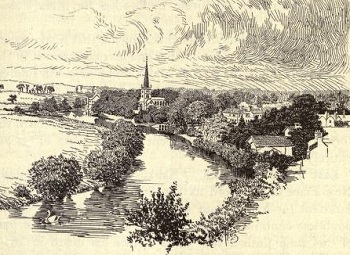
More to Explore
 Shakespeare's Parents Shakespeare's Parents
 Shakespeare's Birth Shakespeare's Birth
 Shakespeare's Siblings Shakespeare's Siblings
 Shakespeare's Education Shakespeare's Education
 Shakespeare the Actor Shakespeare the Actor
 Shakespeare's Lost Years Shakespeare's Lost Years
 Shakespeare's Marriage Shakespeare's Marriage
 Shakespeare's Children Shakespeare's Children
 Shakespeare's Burial Shakespeare's Burial
_____
|
Did You Know? ... Renaissance records of Shakespeare's plays in performance are exceedingly scarce. However, those few contemporary accounts that have survived provide brief yet invaluable information about a handful of Shakespeare's dramas. They give us a sense of what the play-going experience was like while Shakespeare was alive and involved in his own productions, and, in some cases, they help us determine the composition dates of the plays. Of all the records of performance handed down to us, none is more significant than the exhaustive diary of a doctor named Simon Forman. Read on...
|
_____
 Was Shakespeare Italian? Was Shakespeare Italian?
 How Many Plays Did Shakespeare Write? How Many Plays Did Shakespeare Write?
 Shakespeare's Religion Shakespeare's Religion
 Shakespeare's Contemporaries: Top Five Greatest Shakespeare's Contemporaries: Top Five Greatest
 Shakespeare's Audience: The Groundlings Shakespeare's Audience: The Groundlings
 Four Periods of Shakespeare's Life Four Periods of Shakespeare's Life
 Shakespeare's Language Shakespeare's Language
 Words Shakespeare Invented Words Shakespeare Invented
 Shakespeare's Reputation in Elizabethan England Shakespeare's Reputation in Elizabethan England
_____
Bard Bites ...
Elizabethan playhouses were open to the public eye at every turn, and scenery could not be changed in between scenes because there was no curtain to drop. Read on...
____
Most early editors removed five lines from Romeo and Juliet for the sake of common decency. Which lines caused such scandal? Find out...
____
The Elizabethans tried to cure this frightening disease with the inhalation of vaporized mercury salts. Read on...
|
_____
 Shakespeare at the Globe Shakespeare at the Globe
 Shakespeare's Impact on Other Writers Shakespeare's Impact on Other Writers
 Quotations About William Shakespeare Quotations About William Shakespeare
 Shakespeare's Boss: The Master of Revels Shakespeare's Boss: The Master of Revels
 Daily Life in Shakespeare's London Daily Life in Shakespeare's London
 Life in Stratford (structures and guilds) Life in Stratford (structures and guilds)
 Life in Stratford (trades, laws, furniture, hygiene) Life in Stratford (trades, laws, furniture, hygiene)
 Stratford School Days: What Did Shakespeare Read? Stratford School Days: What Did Shakespeare Read?
 Games in Shakespeare's England [A-L] Games in Shakespeare's England [A-L]
 Games in Shakespeare's England [M-Z] Games in Shakespeare's England [M-Z]
 An Elizabethan Christmas An Elizabethan Christmas
 Clothing in Elizabethan England Clothing in Elizabethan England
|
 print; while, again, others value the print even before the bust. But there are one or two good reasons why, in this particular instance, the work of the engraver should be more
highly valued than that of the painter.
print; while, again, others value the print even before the bust. But there are one or two good reasons why, in this particular instance, the work of the engraver should be more
highly valued than that of the painter.
 portrait is certainly not the first in point of genuineness, whatever may be its degree of artistic merit. Possibly it satisfies more fully the popular ideal of the likeness of a great
creative poet than does the bust or print just referred to. Be that as it may, the 'Chandos ' portrait, for various reasons, more than justifies its being kept in the custody of the
nation as a very rare and valuable relic of its greatest dramatist. Its history is, briefly, as follows.
portrait is certainly not the first in point of genuineness, whatever may be its degree of artistic merit. Possibly it satisfies more fully the popular ideal of the likeness of a great
creative poet than does the bust or print just referred to. Be that as it may, the 'Chandos ' portrait, for various reasons, more than justifies its being kept in the custody of the
nation as a very rare and valuable relic of its greatest dramatist. Its history is, briefly, as follows.

 It is believed that when Shakespeare died, on the 23rd April 1616 (o.s.), exactly fifty-two years of age, a cast of his features was taken— by whom is not known, though the
name of the sculptor of the bust, Gerard or Gerald Johnson, a Hollander, has been suggested. Johnson has been credited with having done his part of the work well, since, before its
erection in the chancel of the church, the bust was probably approved by Shakespeare's relations as a good likeness, and deemed worthy of its conspicuous position and of the man
it represented. As is well known to all who have seen the bust, its prominent characteristic is the calm serenity and gentleness of the expression of the features, an expression
that fairly well satisfies the popular ideal of England's
greatest poet.
It is believed that when Shakespeare died, on the 23rd April 1616 (o.s.), exactly fifty-two years of age, a cast of his features was taken— by whom is not known, though the
name of the sculptor of the bust, Gerard or Gerald Johnson, a Hollander, has been suggested. Johnson has been credited with having done his part of the work well, since, before its
erection in the chancel of the church, the bust was probably approved by Shakespeare's relations as a good likeness, and deemed worthy of its conspicuous position and of the man
it represented. As is well known to all who have seen the bust, its prominent characteristic is the calm serenity and gentleness of the expression of the features, an expression
that fairly well satisfies the popular ideal of England's
greatest poet.

 As nothing was
ever known as to what befell the mask after Gerard Johnson had manipulated it in the preparation of the bust — assuming it had been in his hands for that purpose — the finding of
such an extraordinary relic created widespread interest, not only throughout England and Europe, but in America, where also there were those who were ready to believe the
story.
As nothing was
ever known as to what befell the mask after Gerard Johnson had manipulated it in the preparation of the bust — assuming it had been in his hands for that purpose — the finding of
such an extraordinary relic created widespread interest, not only throughout England and Europe, but in America, where also there were those who were ready to believe the
story.